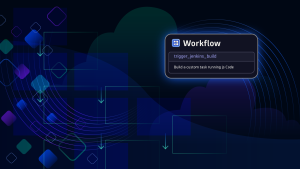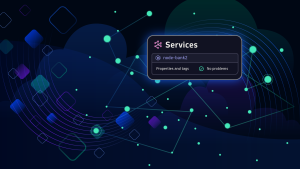Since DevOps emerged in the late 2000s, DevOps automation has been evolving. Now, with causal AI, this automation is evolving from event-driven automation to answer-driven automation.
In the world of DevOps and SRE, DevOps automation answers the undeniable need for efficiency and scalability. Though the industry champions observability as a vital component, it’s become clear that teams need more than data on dashboards to overcome persistent DevOps challenges. DevOps teams need automation that goes beyond passive observations. They need event-driven automation that not only responds to events and triggers but also analyzes and interprets the context to deliver precise and proactive actions. This evolution in automation, referred to as answer-driven automation, empowers teams to address complex issues in real time, optimize workflows, and enhance overall operational efficiency.
In this blog, we will dive into the transformative power of answer-driven automation. We will also explore the evolution of DevOps automation and the significance of data-driven answers in unlocking streamlined, automated DevOps and SRE processes.
The evolution of DevOps automation
Since the concept of DevOps emerged around 2007 and 2008 in response to pain points with Agile development, DevOps automation has been continuously evolving.
Business process automation
Business process automation is the foundation for improving operational efficiency. From automating email communications and backup scheduling to streamlining invoicing and billing processes, organizations have embraced automation to save time and reduce manual effort. These initial automation endeavors paved the way for greater advancements, leading to the next evolution of event-driven automation.
Event-driven automation
Event-driven automation represents a significant leap forward. It harnesses real-time responsiveness to specific rules or events, revolutionizing business operations.
For example, consider an e-commerce website that automatically sends personalized discount codes to customers who abandon their shopping carts. This event-driven automation triggers the action of sending the discount code only when the customer abandons the cart, minimizing revenue loss and increasing conversion rates.
In the realm of cybersecurity, event-driven automation plays a crucial role in threat detection and response. A team can configure its observability platform to detect specific events, such as malicious user requests that could be part of a SQL injection attack or suspicious login attempts. When the platform identifies these events, event-driven automation can automatically trigger actions like blocking IP addresses, initiating incident response protocols, and sending alerts to security or development teams. This proactive approach strengthens the organization’s defense against cyber threats and reduces the time to detect and mitigate potential breaches.
But even the event-driven approach leaves gaps that greater detail and context could fill in. With greater detail and context, organizations can make—and automate—more nuanced decisions with greater impact to operations, security, and the business.
Answer-driven automation
With the advent of AI in operations (AIOps), DevOps teams have an opportunity to apply a more intelligent and comprehensive approach to automation driven by AI. Combining precise, causal AI-powered answers —derived from observability, security, and business data— with predictive AI and automation provides a feedback loop that makes the automation more intelligent and business-value-oriented. This is what answer-driven automation is all about.
Let’s examine a few examples of answer-driven automation using AI and context.
DevOps automation example #1: Online shopping
It has been more than 25 years since Bill Gates coined the phrase “context is king,” yet its relevance persists. Consider the aforementioned scenario of cart abandonment, where the user receives an automated email with a discount code. While this initial step may seem promising, crucial pieces of information (the context) surrounding the transaction remain missing. The absence of these details hampers decision-making. Questions arise, such as the following:
- How substantial is the shopping cart?
- How popular is the product?
- How long has it been lingering in the cart?
- Are there any existing discounts on the product?
- What is the current inventory level?
- Has the user purchased this product before?
Imagine having an AI engine that comprehends the complete context of the transaction and intelligently determines whether to send a discount code—and which one to send. This would propel event-driven automation to new heights. Full contextual awareness helps the AI engine make informed decisions. This revolutionizes the online shopping experience and leads to better conversions and enhanced user satisfaction.
DevOps automation example #2: Threat detection and response
Let’s build on the previous example. While resorting to IP address blocking as a defense measure may seem tempting, it could potentially be an excessive reaction, especially when the true intent behind the event remains unknown. This is where answer-driven automation comes into play. The AI engine becomes your trusted ally, observing the user request behavior within the application. It goes beyond surface-level observations, diving deep into the intricate details to determine outcomes, including the following:
- Is there an exploitable vulnerability?
- Does it constitute a zero-day vulnerability?
- How critical is the vulnerability?
- How adjacent is the vulnerability to the data source?
- Was the user input indeed malicious?
Armed with these precise answers, you gain a crystal-clear understanding of the situation.
The real power lies in the subsequent actions that answer-driven automation triggers. Answer-driven DevOps automation goes beyond creating tickets and extends to executing workflows designed to extract ownership information and then route the ticket to the responsible teams. This seamless handoff ensures that the right team diligently addresses the root cause of the problem, allowing teams to efficiently resolve them. Answer-driven automation mitigates alert storms and significantly reduces the number of false positives. As a result, it saves critical developer time and expedites the mean time to resolution (MTTR). Combining answer-driven automation and comprehensive threat detection and response provides a robust defense mechanism against potential threats. The combination empowers organizations to identify the true nature of events swiftly, take well-informed actions, and proactively address vulnerabilities.
DevOps automation example #3: Progressive delivery
In software development and delivery, if an organization uses feature flags to control feature releases, the marriage of observability data and answer-driven automation becomes a formidable force. Observability data provides a treasure trove of performance, stability, and user experience metrics encompassing error rates, response times, and user engagement. This rich dataset is the foundation for an answer-driven automation solution to work its magic using AI.
With swift precision, an answer-driven automation solution that uses causal AI can transform these metrics into invaluable insights. Such a solution can automatically analyze the impact of newly introduced features or changes facilitated through feature flags. For instance, in the case of poor performance, you can seamlessly toggle a feature flag and mitigate any detrimental effects. Conversely, if the feedback is overwhelmingly positive, you can dynamically expand the feature’s exposure to a wider group of users and unleash its full potential. In this way, answer-driven automation orchestrates the seamless delivery of new features to users while effectively minimizing the impact of potential downtime or negative user experiences.
This powerful synergy between observability data, causal AI insights, and answer-driven automation empowers organizations to embrace progressive delivery with unwavering confidence. It enables them to adapt to user feedback swiftly, fine-tune feature releases, and deliver exceptional user experiences, all while maintaining control and minimizing disruption.
DevOps automation example #4: Intelligent incident management and remediation
We’ve witnessed the power of event-driven automation in generating alerts, creating incident tickets, and executing runbooks to drive remediation efforts. While this level of automation is undeniably beneficial, today’s IT leaders aspire for even greater capabilities. Here, answer-driven automation enables organizations to harness the potential of answers from observability data to achieve self-healing, proactive management.
Consider an event-driven automation system designed for incident management. When a server experiences an outage, the system promptly triggers an alert and initiates actions like restarting a server or redirecting traffic to a redundant server. While this reactive approach effectively restores services, it does not address the underlying cause, which results in recurring incidents.
In contrast, answer-driven automation takes incident management to a new level. Using advanced causal AI and context-aware decision-making, it identifies the root cause behind server failures. The system analyzes performance patterns and historical data to uncover the specific software bug or resource constraint causing the issue.
Thus, in addition to generating alerts and incident tickets, the system can trigger predefined workflows or specific runbooks to deploy software patches and automatically scale up or down resources when necessary. But it doesn’t stop there. Based on all the contextual information, the system can provide predictive answers to auto-scale infrastructure and anticipate future capacity demands, effectively reducing cost, carbon footprint, and downtime. All these actions aim to avert future incidents. And finally, with an observability platform, you can effectively “close the loop” and ensure that any remediation actions fix the issue by continually observing and evaluating SLOs and business objectives. Answer-driven automation holds transformative power within the realm of remediation.
DevOps automation example #5: Safeguarding production
Imagine having the ability to instantly validate the impact of any change to a production application and receive real-time feedback. Change impact analysis is an indispensable process for effectively managing changes within an organization’s infrastructure and applications. It entails evaluating the potential consequences and risks associated with both planned and unplanned changes, ensuring smooth and successful operations.
Let’s consider a scenario where a software development team oversees the deployment of updates to a microservices-based application. Suppose a development team is working on a new feature for a specific service. They intend to roll it out to the production environment. However, they don’t have a comprehensive understanding of the intricate dependencies between the services or the potential impact of the change on the overall system.
To mitigate this uncertainty, the developers can harness causal AI to understand how the change will affect other services. They can also see how the change can affect critical objectives like SLOs and golden signals, such as traffic, latency, saturation, and error rate. This automated validation equips developers with the necessary knowledge to make informed decisions about the deployment, or even prompt them to consider a rollback if necessary. Precise answers derived from causal AI —coupled with answer-driven automation— eliminate the need for guesswork and result in a more reliable, resilient production system.
Answer-driven automation: The new frontier in DevOps automation
The use cases for answer-driven automation are as varied as the DevOps environments they can help to automate. Observability, causal AI, and predictive AI form the basis for enabling answer-driven automation. The Dynatrace platform’s unique approach to delivering precise answers —through root cause analysis from the Davis AI Engine— and intelligent automation can help your organization scale to new heights. By uniting broad, deep observability with precise security analytics capabilities in a single platform to automate DevOps, teams can deliver better, more secure software faster.
Now with AutomationEngine and Workflows, Dynatrace empowers organizations to build, customize, and deploy workflows to help teams realize the full potential of answer-driven automation.
Ready to learn more about the criticality of DevOps automation for CIOs globally? Download the free 2023 CIO Report.





Looking for answers?
Start a new discussion or ask for help in our Q&A forum.
Go to forum